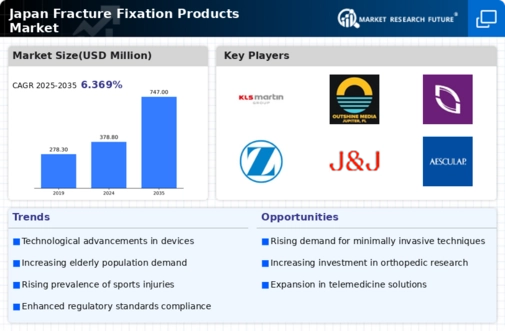Increased Healthcare Expenditure
Japan's healthcare expenditure has been on the rise, which positively impacts the fracture fixation-products market. The government has been investing heavily in healthcare infrastructure and services, with total healthcare spending reaching approximately $500 billion in recent years. This increase in funding allows for the procurement of advanced medical technologies, including state-of-the-art fracture fixation devices. Furthermore, the emphasis on improving healthcare quality and patient care is likely to drive hospitals and clinics to adopt the latest fixation products. As healthcare providers strive to meet the growing demand for effective fracture management, the market for these products is expected to experience substantial growth, reflecting the broader trends in healthcare investment.
Rising Incidence of Bone Fractures
The increasing incidence of bone fractures in Japan is a primary driver for the fracture fixation-products market. Factors such as an aging population and a rise in sports-related injuries contribute to this trend. According to recent statistics, the number of fractures among individuals aged 65 and older has surged by approximately 30% over the past decade. This demographic shift necessitates advanced fixation products to ensure effective treatment and recovery. As a result, healthcare providers are increasingly investing in innovative fracture fixation solutions, which is likely to bolster market growth. The fracture fixation-products market is expected to expand significantly as hospitals and clinics seek to enhance patient outcomes through improved surgical techniques and materials.
Advancements in Surgical Techniques
Innovations in surgical techniques are transforming the landscape of the fracture fixation-products market. Minimally invasive procedures, such as arthroscopy and percutaneous fixation, are gaining traction among orthopedic surgeons in Japan. These techniques not only reduce recovery times but also minimize complications associated with traditional open surgeries. The adoption of advanced fixation devices, such as locking plates and intramedullary nails, is becoming more prevalent, as they offer enhanced stability and support for fractured bones. As a result, the market is witnessing a shift towards products that facilitate these modern surgical approaches. The integration of robotics and imaging technologies further enhances the precision of these procedures, potentially leading to better patient outcomes and driving demand for innovative fixation products.
Growing Awareness of Orthopedic Health
There is a growing awareness of orthopedic health among the Japanese population, which is influencing the fracture fixation-products market. Public health campaigns and educational initiatives are increasingly focusing on the importance of bone health and injury prevention. This heightened awareness is leading to more individuals seeking medical attention for fractures and related conditions. Consequently, healthcare providers are responding by expanding their offerings of fracture fixation products to meet the rising demand. The emphasis on preventive care and early intervention is likely to drive market growth, as patients become more proactive in managing their orthopedic health. This trend suggests a potential shift in consumer behavior, favoring advanced fixation solutions that promote faster recovery and improved quality of life.
Technological Integration in Healthcare
The integration of technology in healthcare is significantly impacting the fracture fixation-products market. The adoption of digital health solutions, such as telemedicine and electronic health records, is streamlining patient management and enhancing the overall treatment process. Additionally, the use of 3D printing technology for custom implants and fixation devices is gaining momentum in Japan. This innovation allows for personalized treatment options that cater to the specific needs of patients, potentially improving surgical outcomes. As healthcare providers increasingly embrace these technological advancements, the demand for sophisticated fracture fixation products is likely to rise. This trend indicates a shift towards more patient-centered care, where technology plays a crucial role in enhancing the effectiveness of fracture management.

















Leave a Comment